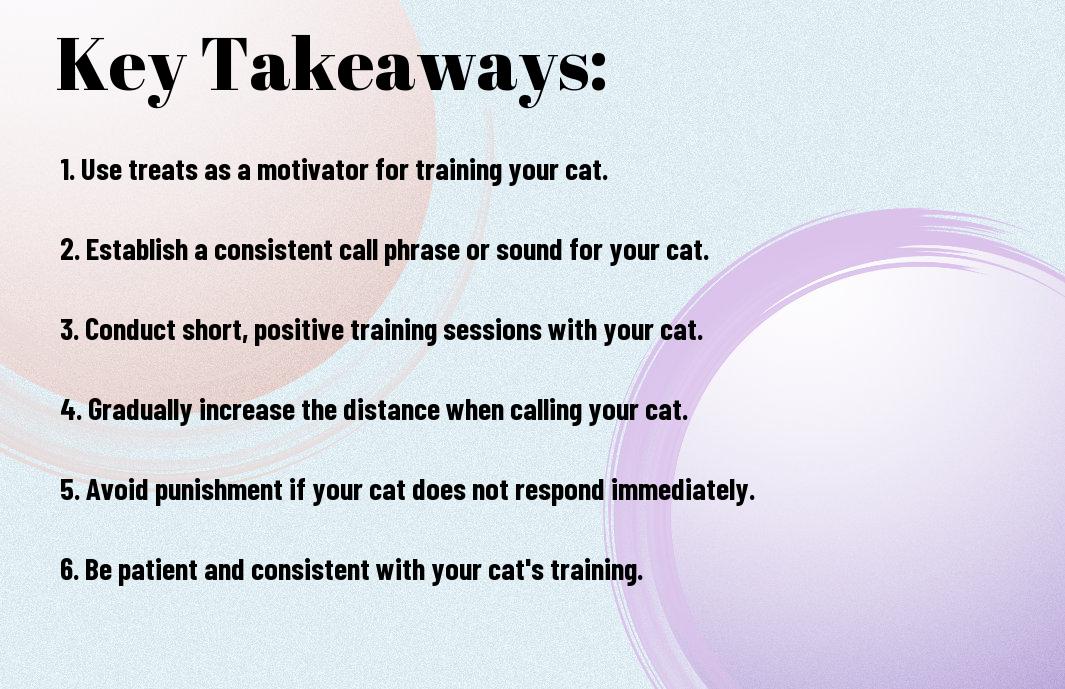Have you ever wondered if it’s possible to train your feline friend to come when called? You’ll be pleased to know that yes, it is indeed possible to teach your cat to respond to your call. However, it’s important to approach this process with patience and a clear understanding of your cat’s behavior. In this blog post, we will discuss effective training techniques to help you successfully teach your cat to come when called, as well as some common pitfalls to avoid. By following these tips, you can establish a strong bond with your cat and improve their responsiveness to your calls.
Key Takeaways:
- Consistency is key: Training your cat to come when called requires consistency in both the command and the reward system.
- Use positive reinforcement: Reward your cat with treats or praise every time they come when called to reinforce the behavior.
- Start training early: It’s easier to train a cat to come when called when they are young, but older cats can learn with patience and persistence.
- Keep training sessions short: Cats have short attention spans, so keep training sessions brief and end on a positive note to keep them engaged.
- Be patient and persistent: Training a cat to come when called takes time, so be patient and keep practicing the command consistently.


Establishing the Basics
The first step in training your cat to come when called is to establish the basics. This involves understanding the principles of cat training and familiarizing yourself with the process. You can find detailed information on how to train a cat to come here.
Selecting the Right Stimulus
When training your cat to come when called, it’s important to select the right stimulus that will grab their attention. This could be a specific sound, such as a clicking noise or a word like “treat.” It’s crucial to choose a stimulus that is consistent and easily distinguishable from other sounds in your home.
Consistency is Key in Training
Consistency is fundamental to successful training. When teaching your cat to come when called, make sure to use the same word or sound each time. Additionally, employ the same body language and tone of voice to reinforce the command. Consistency helps your cat understand what is expected of them and makes the training process more effective.

Advanced Training Techniques
Despite mastering the basic recall training, you may want to take your cat’s training to the next level. Advanced training techniques can further improve your cat’s response to your call and help strengthen the bond between you and your feline friend. Here are some advanced training techniques to consider:
- Gradual Distance Increase Method: This training technique involves gradually increasing the distance from which you call your cat. By starting close and gradually extending the distance, you can teach your cat to respond to your call from farther away. This method requires patience and consistency, but it can be highly effective in reinforcing your cat’s recall response.
- Positive Reinforcement Strategies: Using positive reinforcement, such as treats, praise, and play, can be a powerful way to enhance your cat’s recall training. By rewarding your cat each time they come to you when called, you can reinforce the behavior and motivate them to respond consistently.
Gradual Distance Increase Method
When using the gradual distance increase method, you will start by calling your cat from a short distance away, such as the next room. Once your cat reliably comes to you from this distance, gradually increase the distance over time. Start by calling your cat from slightly farther away and continue to increase the distance as your cat becomes more proficient at responding to your call. Remember to always use a positive tone and offer a reward when your cat comes to you, no matter the distance.
Positive Reinforcement Strategies
Positive reinforcement is a powerful tool in cat training. When working on recall training, ensure that you always reward your cat for coming to you when called. Use your cat’s favorite treats, toys, or verbal praise to reinforce the behavior. This will help create a positive association with coming when called and encourage your cat to do so consistently. Remember to be patient and consistent in your training, as this will help your cat understand what is expected of them.
Common Challenges and Solutions
To effectively train your cat to come when called, you may encounter some common challenges. However, with the right approach and consistency, these challenges can be overcome. Here are some common challenges and solutions to help you train your cat successfully.
Dealing with Distractions
When training your cat to come when called, distractions can hinder progress. Your cat may be easily distracted by other animals, toys, or even the sounds and sights outside. To address this challenge, find a quiet, enclosed space for training sessions. Minimize distractions by keeping the environment calm and free from other pets or loud noises. Additionally, you can gradually introduce distractions as your cat becomes more proficient at responding to your call, using positive reinforcement to keep their focus on you.
Maintaining Training Over Time
One of the challenges you may face is maintaining your cat’s training over time. Cats, like humans, can become complacent if not consistently reinforced. To prevent regression in their training, it’s important to continue practicing the recall command regularly. Make it a part of your daily interaction with your cat, using treats and praise to reinforce the behavior. You can also incorporate the recall command into daily activities such as feeding time or playtime to keep it fresh in your cat’s mind.
Conclusion
To wrap up, training your cat to come when called is a process that requires patience, consistency, and positive reinforcement. By using treats, a clicker, and a consistent verbal cue, you can teach your cat to respond to your call. Remember to keep training sessions short and positive to keep your cat engaged and willing to participate. With time and dedication, you can successfully train your cat to come to you whenever you call.
FAQ
Q: How can I train my cat to come when called?
A: Training your cat to come when called is possible with patience and repetition. Start by using a clicker or a specific word as a cue, and always reward your cat with a treat or affection when they come to you. Gradually increase the distance and distractions when practicing, and be consistent with your training sessions.
Q: Is it possible to train any cat to come when called?
A: While some cats may be more independent or less motivated by treats, it is possible to train most cats to come when called. The key is to find what motivates your cat and be patient in the training process. Some cats may take longer to learn, but with consistent training, they can eventually understand the command.
Q: What are some common mistakes to avoid when training a cat to come when called?
A: One common mistake is using the cat’s name in a negative context, which can associate their name with punishment and make it less likely for them to come when called. Additionally, being inconsistent or using multiple cues for the same command can confuse the cat. It’s important to be patient, use positive reinforcement, and avoid forcing the cat to come to you, as it can create a negative association with the training.

Jayley, a devoted cat enthusiast, also writer for other cat blog as well. She aims to dedicated to providing comprehensive information, insights, and advice on everything you’d ever want to know about our whiskered companions.
